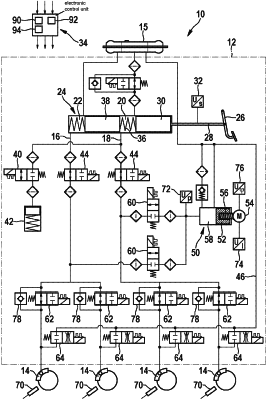| CPC B60T 8/94 (2013.01) [B60T 13/686 (2013.01); B60T 13/745 (2013.01); B60T 17/221 (2013.01); B60T 2270/10 (2013.01); B60T 2270/402 (2013.01); B60T 2270/406 (2013.01)] | 5 Claims |

|
1. An electronically slip-controllable power braking system for a motor vehicle, comprising:
a controllably driven pressure generator;
multiple brake circuits connected in parallel to one another to the pressure generator, each respective brake circuit of the brake circuits respectively having an electronically controllable first control valve for separating the respective brake circuit from the pressure generator, and an electronically controllable second control valve situated downstream from first control valve for controlling a brake pressure in a wheel brake coupled to the respective brake circuit; and
an electronic control unit configured to activate the pressure generator and the first and second control valves, wherein the electronic control unit is equipped with a first device configured to check the brake circuits for leak tightness and to initiate decoupling at least indirectly from the pressure generator when a leakiness is established, a second device configured to compare signal variables representing pressures to one another, and a third device configured to put the first control valve of a brake circuit of the brake circuit into a passage position if a leakiness of the brake circuit is established and a pressure built up by the pressure generator has at least approximately reached or exceeded a pressure limit of the first control valve of the brake circuit.
|